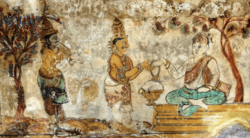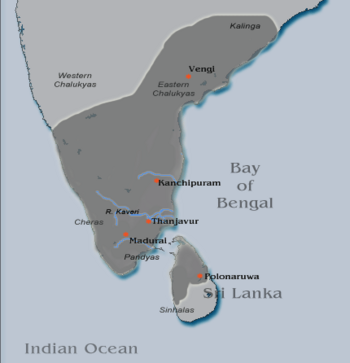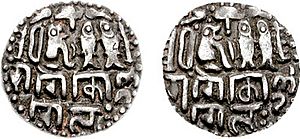Rajaraja I facts for kids
Quick facts for kids Rajaraja I |
|
|---|---|
| Rājakēsari Mum'muṭi Cōḻan, sivapathasekaran, thelungu kulakaalan, thaila kula kaalan, Pandiya kula sani, keralandhagan, singalandhagan |
|
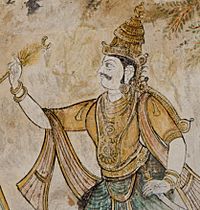
A Mural of Rajaraja I at Brihadisvara Temple.
|
|
| Chola Emperor | |
| Reign | c. 985 – c. 1014 |
| Predecessor | Uttama Chola |
| Successor | Rajendra I |
| King of Anuradhapura |
|
| Reign | c. 992 – c. 1014 |
| Predecessor | Mahinda V |
| Successor | Rajendra I |
| Born | Arunmozhi Varman c. 947 Thanjavur, Chola Empire (modern day Tamil Nadu, India) |
| Died | 1014 (aged 66–67) Thanjavur, Chola Empire (modern day Tamil Nadu, India) |
| Queens | Thiripuvana Madeviyar Lokamahadevi Cholamahadevi Trailokyamahadevi, Panchavanmahadevi Abhimanavalli Latamahadevi Prithivimahadevi |
| Issue |
|
| Dynasty | Chola |
| Father | Parantaka II |
| Mother | Vanavan Mahadevi |
| Religion | Hinduism See details |
| Signature | |
Rajaraja I (born around 947 CE – died 1014 CE) was a powerful emperor of the Chola dynasty. He ruled from 985 CE to 1014 CE. Rajaraja, often called Rajaraja the Great, was the strongest Tamil king in South India during his time. He is famous for making the Chola Empire very strong again and for expanding its power across the Indian Ocean.
His large empire included big parts of the Pandya and Chera regions, and northern Sri Lanka. He also took control of Lakshadweep, the Thiladhunmadulu atoll, and some northern islands of the Maldives. Rajaraja also fought against the Western Gangas and the Chalukyas, extending Chola rule up to the Tungabhadra River. On the eastern coast, he fought the Chalukyas for control of Vengi.
Rajaraja I was a skilled leader. He built the amazing Rajarajeshwaram Temple in the Chola capital, Thanjavur. This temple is considered one of the best examples of medieval South Indian architecture. During his rule, the writings of famous Tamil poets like Appar, Sambandar, and Sundarar were gathered into a collection called Thirumurai. In 1000 CE, he started a huge project to survey and measure land, which helped organize the country into new areas called valanadus. Rajaraja died in 1014 CE, and his son, Rajendra Chola I, became the next emperor.
Contents
Early Life of Rajaraja
Rajaraja was the son of Chola king Parantaka II and queen Vanavan Mahadevi. His birth name was Arulmoḻi Varman, which means "blessed tongued." He was born around 947 CE. He had an older brother, Aditya II, and an older sister, Kundavai.
Rajaraja becoming king ended a time when different people were trying to claim the throne. This happened after the death of his great-grandfather, Parantaka I. After Parantaka I, his older son Gandaraditya became king. When Gandaraditya died, his son Uttama was too young to rule. So, the throne went to Parantaka I's younger son, Arinjaya. Arinjaya died soon after, and his son Parantaka II became king. It was decided that Uttama would become king after Parantaka II.
Rajaraja's older brother died before him. After Uttama's death, Rajaraja became king in June–July 985 CE. Until then, he was known as Arumoḷi Varman. When he became king, he took the name Rajaraja, which means "King among Kings."
Rajaraja's Military Victories
When Rajaraja became king, his kingdom was small. It was mainly around the Thanjavur and Tiruchirappalli areas. The kingdom was still recovering from earlier attacks by the Rashtrakutas. Rajaraja changed this. He built a strong army and navy and made his empire very well-organized. During his rule, the northern kingdom of Vengi became a Chola protectorate, meaning it was protected and controlled by the Cholas. Chola power on the eastern coast reached as far north as Kalinga.
The records from Thanjavur mention many army groups. These groups included elephant troops, cavalry (soldiers on horses), and infantry (soldiers on foot). Each group had its own freedom and could give gifts or build temples.
Battle at Kandalur Salai
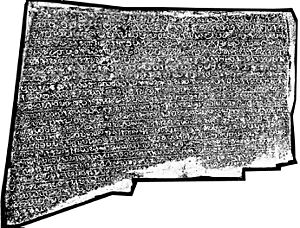
Rajaraja's first records celebrate a big win at Kandalur Salai (in modern-day Kerala) around 988 CE. He was called "the one who destroyed Kandalur Salai." This place originally belonged to the Ay chief, who was a local ruler under the Pandya king in Madurai. It's not clear if Chera or Pandya warriors were involved in this battle. Rajaraja's records also say his general captured Vizhinjam. This victory might have been part of the Kandalur Salai campaign. This battle seems to have been fought by the Chola navy or by both the navy and the army together.
Taking Control of Kerala and the Pandyas
Rajaraja's records start appearing in the Kanyakumari district in the 990s and in the Trivandrum district in the early 1000s. The Cholas took control of Kerala in the early 11th century. A record from Senur (1005 CE) says that Rajaraja destroyed the Pandya capital, Madurai. He also conquered the "proud kings" of Kollam (Venad), Kolla-desham (Mushika), and Kodungallur (the Chera Perumal). Some of these wins in Malainadu might have been achieved by his son, Prince Rajendra Chola, for his father.
After defeating the Pandyas, Rajaraja took the title Pandya Kulashani. This means "Thunderbolt to the Race of the Pandyas." The Pandya region then became known as "Rajaraja Mandalam" or "Rajaraja Pandinadu."
After making his rule strong in the south, Rajaraja took the title Mummudi Chola. This means "three Crowned," showing that he controlled the three ancient Tamil kingdoms: the Cholas, the Pandyas, and the Cheras.
Conquering Sri Lanka
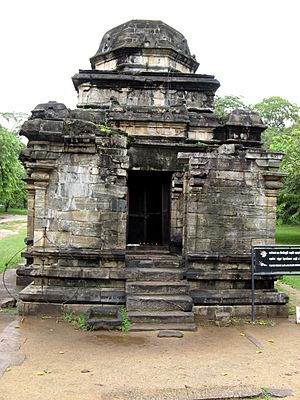
In 993 CE, Rajaraja invaded Sri Lanka, which was called Ila-mandalam in Chola records. This invasion likely happened when Mahinda V of Anuradhapura was king. According to the Chulavamsa history book, Mahinda V had to flee to Rohana (Ruhuna) in southeastern Sri Lanka because of a military uprising. The Chola army attacked Anuradhapura and took control of the northern part of Sri Lanka. The Cholas set up a new capital at the military base of Polonnaruwa. They named it Jananathamangalam, after one of Rajaraja's titles. A Chola official named Tali Kumaran built a Shiva temple called Rajarajeshwara ("Lord of Rajaraja") in the town of Mahatirtha (modern Mantota), which was renamed Rajarajapura.
In 1017 CE, Rajaraja's son Rajendra I finished the Chola conquest of Sri Lanka. The Cholas ruled Sri Lanka until 1070 CE, when Vijayabahu I defeated and drove them out.
Conflict with the Chalukyas
In 998 CE, Rajaraja captured the regions of Gangapadi, Nolambapadi, and Tadigaipadi (which are in present-day Karnataka). Rajaraja defeated the Nolambas, who were local rulers under the Ganga kingdom, and took over Nolambapadi. These areas were originally under the Rashtrakutas. In 973 CE, the Rashtrakutas were defeated by the Western Chalukyas. This led to direct conflicts with the Cholas.
By 1004 CE, Rajaraja had conquered the Gangavadi province. The Changalvas and Kongalvas, who ruled parts of this area, became his vassals (local rulers under his control). Rajaraja defeated Jata Choda Bhima, who ruled the Vengi kingdom. Rajaraja then placed Saktivarman on the throne of Vengi as a viceroy, meaning he ruled on behalf of the Chola Dynasty. After the Chola army left, Bhima took back Kanchi in 1001 CE. Rajaraja then drove out and killed Bhima, putting Saktivarman I back on the Vengi throne. Rajaraja also married his daughter Kundavai to his next viceroy of Vengi, Vimaladitya. This marriage brought the Chola Dynasty and the Eastern Chalukya Kingdom closer, making sure that Rajaraja's descendants would rule the Eastern Chalukya kingdom in the future.
One of Rajaraja's last victories was taking control of the Maldives islands by sea. These islands were called "the Ancient Islands of the Sea Numbering 1200." This naval campaign showed how powerful the Chola navy was in the Indian Ocean.
The Cholas controlled the area around the Bay of Bengal, with Nagapattinam as their main port. The Chola Navy also played a big part in the invasion of Sri Lanka. Rajaraja's success allowed his son Rajendra Chola to lead the Chola invasion of Srivijaya. This involved naval attacks in Southeast Asia and a short occupation of Kadaram.
Rajaraja's Personal Life
Rajaraja had several wives, including Vanavan Madevi, Lokamadevi, and Panchavan Madeviyar. He had at least three daughters. He had two sons: Rajendra Chola I with Thiripuvāna Mādēviyār, and a younger son named Araiyan Rajarajan. His first daughter, Kundavai, was with Lokamadevi. Kundavai married the Chalukya prince Vimaladithan. Rajaraja also had two other daughters named Mathevadigal and Ģangamādevi. Rajaraja died in 1014 CE and was followed by his son, Rajendra Chola I.
How Rajaraja Ruled His Empire
Before Rajaraja I became king, parts of the Chola land were ruled by local lords and princes. They had a loose agreement with the Chola rulers. In 1000 CE, Rajaraja started a project to survey and measure all the land. This led to the empire being reorganized into new units called valanadus. From Rajaraja I's time until the rule of Vikrama Chola in 1133 CE, these local lords were either replaced or made into officials who reported to the king. This allowed the king to have more direct control over different parts of the empire. Rajaraja also made local self-government stronger. He set up a system to check and control village assemblies and other public groups, while still letting them have some independence. To help with trade, he sent the first Chola group to China.
His older sister, Kundavai, helped him with ruling and managing temples.
Important Officials
Rajendra Chola I was made a co-ruler during the last years of Rajaraja's reign. He was the main commander of the northern and northwestern parts of the empire. During Rajaraja's rule, the government structure grew, and there were more officials than before. Villavan Muvendavelan, one of Rajaraja's top officials, is mentioned in many of his records. Other officials mentioned include the Bana prince Narasimhavarman, a general named Senapathi Krishnan Raman, the chief Vallavaraiyan Vandiyadevan, the tax official Irayiravan Pallavarayan, and Kuruvan Ulagalandan, who organized the land surveys across the country.
Rajaraja's Religious Beliefs
Rajaraja followed the Shaivism branch of Hinduism, which worships Lord Shiva. However, he also built several temples dedicated to Vishnu.
In the 11th century CE, a Buddhist monastery called the Chudamani Vihara was built in Nagapattinam. It was built by the Sailendra king of Srivijaya, Sri Mara Vijayattungavarman, with support from Rajaraja I. It was named Chudamani after King Sri Mara's father. Rajaraja gave money from the village of Anaimangalam to help maintain this monastery.
Rajaraja called himself Shivapada Shekhara, which means "the one who places his crown at the feet of Shiva."
Arts and Architecture During Rajaraja's Rule
Rajaraja started a project to find and collect ancient hymns after hearing parts of Thevaram in his court. He asked Nambi Andar Nambi for help. It is believed that Nambi found the writings on palm leaves, partly eaten by termites, in a room inside the Thillai Nataraja Temple, Chidambaram. The priests in the temple were against this project, but Rajaraja stepped in. He had statues of the saint-poets carried through the streets of Chidambaram. Because of this, Rajaraja became known as Tirumurai Kanda Cholan, meaning "the one who saved the Tirumurai."
Before Rajaraja, Shiva temples only had statues of gods. But after Rajaraja, statues of the Nayanar saints (devoted followers of Shiva) were also placed inside the temples.
Brihadisvara Temple
In 1010 CE, Rajaraja built the amazing Brihadisvara Temple in Thanjavur. It is dedicated to Lord Shiva. The temple and the capital city were important centers for both religion and trade. It is also known as Periya Kovil (Big Temple) and Rajarajeswaram. It is one of the largest temples in India and a great example of Dravidian architecture from the Chola period. The temple turned 1000 years old in 2010. It is part of the UNESCO World Heritage Site called "Great Living Chola Temples," along with two other temples.
The vimanam (temple tower) is 216 feet (66 meters) high, making it one of the tallest in the world. The Kumbam (the top part of the temple) is carved from a single rock and weighs about 80 tons. At the entrance, there is a large statue of Nandi (a sacred bull), carved from a single rock. It is about 16 feet long and 13 feet high. The entire temple is made of granite. The closest places to find this stone are about 60 km (37 miles) west of the temple. This temple is one of the most visited tourist spots in Tamil Nadu.
Chola Coins
Before Rajaraja's rule, Chola coins had a tiger symbol on one side. They also had the fish and bow symbols of the Pandya and Chera Dynasties. On the other side, they had the king's name. But during Rajaraja's time, new types of coins appeared. These new coins showed a standing king on one side and a seated goddess on the other. These coins were used in a large part of South India and were even copied by the kings of Sri Lanka.
Inscriptions and Records
Rajaraja wanted to record his military achievements, so he had important events from his life carved into stone. An inscription in Tamil from Mulbagal in Karnataka shows his achievements as early as his 19th year as king.
Rajaraja recorded all the gifts made to the Thanjavur temple and his achievements. He also kept records of the kings who ruled before him. One record from his reign, found at Tirumalavadi, states that the king ordered the main shrine of the Vaidyanatha temple there to be rebuilt. Before taking down the walls, the inscriptions on them had to be copied into a book. After the rebuilding was done, the records were carved back onto the new walls from the book.
Another inscription from the Gramardhanathesvara temple in South Arcot district, from the seventh year of Rajaraja's rule, mentions the fifteenth year of his predecessor, Uttama Choladeva. Uttama Choladeva is described as the son of Sembiyan-Madeviyar.
See also
- List of Tamil monarchs


